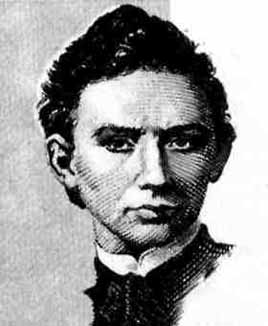- János Bolyai
Infobox Scientist
name = János Bolyai
image_width = 200px
caption = Unauthentic portrait of Bolyai
birth_date = birth date|1802|12|15|df=y
birth_place = Klausenburg, Transylvania, todayCluj-Napoca ,Romania
residence =Austrian Empire
citizenship =
nationality = Austrian
ethnicity = Hungarian
death_date = death date and age|1860|1| 27|1802|12|15|df=y
alma_mater =
doctoral_advisor =
academic_advisors =
doctoral_students =
notable_students =
known_for =non-Euclidean geometry
author_abbrev_bot =
author_abbrev_zoo =
influences =
death_place = Neumarkt, Transylvania, todayTârgu Mureş ,Romania
fields =Mathematics
influenced =
awards =
religion =
footnotes =János Bolyai (
December 15 ,1802 –January 27 ,1860 ) was a Hungarianmathematician , known for his work innon-Euclidean geometry .Bolyai was born in Klausenburg,
Transylvania (today Cluj-Napoca,Romania ), the son of a well-known mathematician,Farkas Bolyai .By the age of 13, he had mastered
calculus and other forms ofanalytical mechanics , receiving instruction from his father. He studied at theRoyal Engineering College inVienna from 1818 to 1822.He became so obsessed withEuclid 'sparallel postulate that his father wrote to him: "For God's sake, I beseech you, give it up. Fear it no less than sensual passions because it too may take all your time and deprive you of your health, peace of mind and happiness in life".János, however, persisted in his quest and eventually came to the conclusion that the postulate is independent of the other axioms of geometry and that different consistent geometries can be constructed on its negation.He wrote to his father: "Out of nothing I have created a strange new universe". [cite book|title=On the Shoulders of Giants|author=Lines, Malcolm E.|isbn=0750301031|year=1994] Between 1820 and 1823 he prepared a treatise on a complete system ofnon-Euclidean geometry . Bolyai's work was published in 1832 as an appendix to a mathematics textbook by his father.Gauss, on reading the Appendix, wrote to a friend saying "I regard this young
geometer Bolyai as a genius of the first order". In 1848 Bolyai discovered not only that Lobachevsky had published a similar piece of work in 1829, but also ageneralization of this theory. As far as we know, Lobachevsky published his work a few years earlier than Bolyai, but it contained only hyperbolic geometry. Bolyai and Lobachevsky didn't know each other or each other's works.In addition to his work in geometry, Bolyai developed a rigorous geometric concept of
complex numbers as ordered pairs ofreal numbers . Although he never published more than the 24 pages of the Appendix, he left more than 20,000 pages of mathematical manuscripts when he died. These can now be found in theBolyai-Teleki library inTârgu-Mureş , Romania, where Bolyai died.He was an accomplished polyglot speaking nine foreign
language s, including Chinese and Tibetan.No original portrait of Bolyai survives. An unauthentic picture appears in some encyclopedias and on a Hungarian postage stamp.
Legacy
The
Babeş-Bolyai University in Cluj-Napoca bears his name, as does the Bolyai crater on theMoon [http://lunar.arc.nasa.gov/printerready/science/geography_items/carters/craters_b.html] .Also, in theCarpathian basin , many high schools bear his name.References
*Martin Gardner , "Non-Euclidean Geometry", Chapter 4 of "The Colossal Book of Mathematics", W.W.Norton & Company, 2001, ISBN 0-393-02023-1
* M. J. Greenberg, "Euclidean and Non-Euclidean Geometries: Development and History", 3rd edition, W. H. Freeman, 1994External links
*
*
Wikimedia Foundation. 2010.
